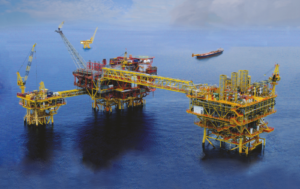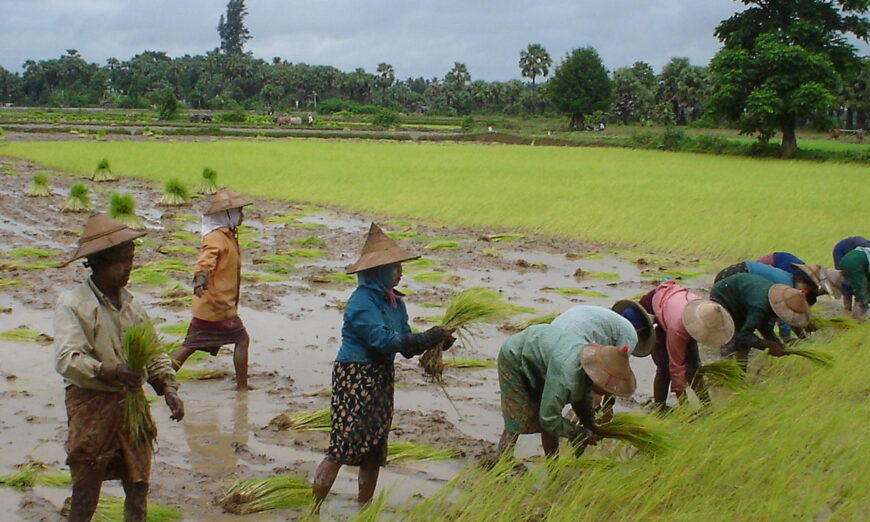Agriculture
Myanmar is an agro-based country with fertile land and abundant water resources. Given the landscape profile, topographic dimensions and different climatic areas of Myanmar – not only perennial plants, but also crops such as rice, pulses and beans, fruits and vegetables can be easily grown. The government is aiming to transform Myanmar’s mostly traditional agricultural economy into a productive and sustainable agro-economy. The agriculture sector has always traditionally been Myanmar’s main industry, employing over half of the labor force. To achieve this goal, increases in agricultural productivity and quality are required. The agriculture can be boosted via distribution of low-cost irrigation systems to rural communities (e.g. solar-powered, with instruction), leasing of agricultural tools and machinery. distribution of high-quality seeds for higher yields (e.g. rice unification in cooperation with the Myanmar Agricultural Bank to incentivise conversion of communities to agriculture with higher productivity levels), establishment of the production of fertilisers, crop protection chemicals etc., contract farming (i.e. direct sourcing from rural communities – based on partnership agreements), introducing value-added production/processing based on local agricultural produce (e.g. groundnut, sesame), establish packaging/canning industry for agricultural produce and establishment of research and training institutions or demonstration farms on integrated agriculture, crop sequencing, fertiliser use, organic agriculture and agriculture-related business skill development. In terms of Myanmar’s main crop production, it is renowned for its production of rice, sugar cane, and dry beans, among other vegetables. Interestingly, Myanmar was once the biggest exporter of rice in Asia. Taking this into consideration, it does not seem too surprising that rice is Myanmar’s most vital agricultural commodity.
The then Myanmar Minister of Agriculture visited India in September 2022. Agriculture sector dominates trade, particularly supply of beans & pulses to India ($ 809 million, 2016-17) and timber ($ 156 million). India’s exports to Myanmar include sugar ($ 424 million), pharmaceuticals ($ 184 million), etc.
Aquaculture and Fisheries
Given Myanmar’s 2,832 kilometers of coastline along the Bay of Bengal and in the Andaman Sea, fisheries represent an important opportunity for communities and businesses in the coastal areas of Myanmar (particularly in Rakhine State). Fishing grounds in Myanmar’s waters are relatively less exploited than elsewhere. The aquaculture sector is operating almost 50,000 hectares of freshwater ponds. Opportunities in the sector exist inshore (e.g. fish ponds, inland river systems and aquaculture), offshore, and in deep sea locations. Key opportunities exist in capture and aquaculture of different types of fish, shrimp and prawn, fish and seafood processing facilities, fish food production, cooling, canning and packaging facilities an establishment of education and research institutions to broaden knowledge and enhance human resources available to the fisheries sector. Myanmar’s fishery sector is endowed with great potential to contribute to food security, income generation, trade, employment opportunities and overall economic development. The country is rich in fishery resources and, in order to tap this potential. Myanmar Exports of fish, live to India was US$720.69 Thousand during 2022, according to the United Nations COMTRADE database on international trade.
Tourism and Hospitality
The tourism and hospitality sector in Myanmar has been rapidly evolving following the political and economic opening of the country. At the moment, foreign tourists (on their first short-term visit to Myanmar) mostly visit Yangon, Bagan, Inle Lake, Nyaung Shwe and Mandalay. However, Myanmar offers many additional unexplored treasures of natural beauty – from Kawthaung in the tropical South-East, to Putao in the Himalaya. Myanmar has resumed international flights and is focusing on attracting tourists from ASEAN countries. The government has reinstated a visa exemption for travellers from ASEAN countries, and tourists from 100 countries can apply for the Tourist eVisa. Moreover, the Ministry of Immigration and Population has allowed ordinary passport holders from Brunei, Cambodia, Indonesia, Laos, Philippines, Thailand, and Vietnam to stay for up to 14 days if entering and departing from Yangon, Mandalay, or Nay Pyi Daw international airports. These efforts demonstrate Myanmar’s commitment to revitalizing its tourism industry and welcoming visitors from around the world. Myanmar will offer visas on arrival to Chinese and Indian tourists. Holders of the visas will be allowed to visit all sites apart from restricted areas for security concerns. Currently citizens of both countries must apply for a tourist visa online, or at a Myanmar embassy. Recently, the External Affairs Minister S Jaishankar met his Myanmar counterpart Tha Swe to discuss about the India-Myanmar-Thailand trilateral highway. The project which will boost tourism and trade between the three nations will link Moreh in Manipur with Mae Sot in Thailand, while passing through Myanmar.

Power Sector
According to the regime’s Ministry of Electric Power (MOEP), the annual need for power consumption in Burma is increasing annually from 15 percent to 17 percent. To fill the gap in energy needs, the government plans to implement an energy mix including hydropower, natural gas, coal, and renewable energy to provide electrical access to approximately ten million households as part of the National Electrification Plan(NEP) which envisions 100 percent nationwide electricity access by the year 2030.There are many opportunities for investors to help Myanmar reach the objective of full national electrification by 2030. To achieve Myanmar’s electrification goals, strong investment for infrastructure development and power generation will be required to increase the current installed capacity of 4,800 MW towards doubling the power capacity. In the medium run, Myanmar may even be able to develop into a net exporter of electricity to neighboring countries. Medium and large-scale electric power generating projects are connected to the National Grid must make Power Purchase Agreement (PPA) with Ministry of Electricity and Energy. Electric power generation projects can be conducted on IPP/BOO, IPP/BOT or BOT basis. A team of forty professionals from Myanmar who are working in power sector and associated areas is in India to enhance their professional competencies. The forty participants have come to India, to attend two training programmes, one on “Microgrids” and the other on “Electric Vehicles, Batteries & Charging Stations”. The programmes are being conducted by India’s largest integrated energy company NTPC Limited. The two programmes are a part of five training programmes for Myanmar’s power sector professionals, which are being conducted by NTPC, under the India-Myanmar Government-to-Government framework for cooperation in power sector. The trainings are being offered under the auspices of Indian Technical and Economic Cooperation (ITEC) Programme, the leading capacity building platform of the Ministry of External Affairs, Government of India.
Energy Sector (Oil and Gas)
Myanmar possesses natural resources in abundance so foreign investments may be invited based on exploration and extraction of natural resources. Currently, exploration and production of offshore and onshore oil and gas blocks are in tender process according to Ministry of Electricity and Energy. There may be more foreign investments in oil and gas sector after tender process. Myanmar has one of the most diverse energy sectors in ASEAN region consisting of the following energy sources: 62 hydropower projects, 1 coal-fired power plant, 20 gas-fired power plants and numerous renewable and solar power projects across the country. The dynamic Oil and Gas sector reflects the high demand of electricity consumption generated by the government’s ambitious Myanmar Energy Master Plan (MEMP). India’s oil and gas investments in Myanmar date back to at least 2002, when ONGC’s overseas arm – ONGC Videsh (International) Ltd – acquired a 20% stake in a 2,129 sq km block off the Rakhine coast in north-western Myanmar. Myanmar is potentially an important partner in the energy sector as future offshore gas finds can be piped to India. India currently has a Joint Working Group (JWG) on Oil and Gas, a Joint Steering Committee (JSC) & a Joint Working Group (JWG) on Power cooperation and a Joint Working Group (JWG) on Renewable Energy.
Manufacturing
The manufacturing sector opens up opportunities due to the significant domestic market of Myanmar, direct access to the strategic markets of Southeast Asia (ASEAN Economic Community) as well as to China and India. Myanmar also has comparatively low labor costs, rich natural resource endowments, and a diverse agricultural base for further value-added production to help encourage growth of the manufacturing sector. Manufacturing sector is set to be a main source supported to the country’s economic growth and it is significantly potential for the long-term. The main concern behind the sector development is a strategic location for foreign investment along with the attractive incentives in accordance with Special Economic Zone Law and Myanmar Investment Law. Currently, there are about 100 Indian companies in Myanmar with investments over 1.2 billion, according to the Indian embassy in Yangon. According to India’s Exim Bank, some of the Indian companies with a presence in Myanmar include ONGC Videsh Limited (OVL), Jubilant Oil and Gas, Century Ply, Tata Motors, Essar Energy, RITES, Escorts, Sonalika Tractors, Zydus Pharmaceuticals Ltd., Sun Pharmaceuticals Ltd, Ranbaxy,Cadila Healthcare Ltd, Shree Balaji Enterprises, Shree Cements, Dr. Reddy’s Laboratories, CIPLA, Gati Shipping Ltd, TCI Seaways, Apollo and AMRI.
Forest-Based Industries
Myanmar is one of the leading producers of teak and hardwood (particularly Pyinkadoe and Padauk). In order to prevent unsustainable forestry practices and large-scale log harvesting, the Government of Myanmar strictly and effectively abandoned the export of unprocessed teak and hardwood in April 2014. This structural change offers opportunities to foreign and local investors to support the emergence of value-added and sustainable forestry (e.g.by establishing new wood-processing industries in Myanmar). Furthermore, stronger engagement of the private sector to help restore forests in an environmentally and economically sustainable way is desired. Key Opportunities in Forestry-Based Industries are-establishment of wood-processing industries (e.g. furniture production), expansion of bamboo forests and bamboo-based production (i.e. handicrafts), rubber-based industries (e.g. tyre production in Mon and Karen state),teak and hardwood plantations, sandalwood-processing industries and community-based forestry. Myanmar teak is highly valued for its durability, water resistance, and resistance to termites. It is commonly used for high-end furniture, veneers, and ship decking, especially in the luxury yacht industry. Indian companies imported over $10 million worth of teak wood from Myanmar between February 2021 and April 2022. India is the world’s largest importer of teak and the world’s largest exporter of processed teak wood products. Therefore, the teak trade with Myanmar is significant for the Indian economy.
Mining Sector
Myanmar possesses natural resources in abundance, including the following minerals: Alum, Amber, Antimony, Barite, Bauxite, Beryl, Bismuth, Cadmium, Chromite, Cinnebar, Coal, Cobalt, Columbite, Copper, Corundum, Gemstones, Gold, Graphite, Gypsum, Iridium, Iron Ore, Jadeite, Kaolin, Lead, Manganese, Mica, Molybdenum, Natural Gas, Nickel, Ochre, Oil, Oil Shale, Phosphates, Platinum, Salt, Saltpetre, Silver, Soda, Steatite, Sulphates, Sulphides, Sulphur, Tin, Titanium, Tungsten and Zinc. Investors may support the responsible exploration and extraction of natural resources according to international best practices. Myanmar is a candidate of the Extractive Industries Transparency Initiative. Key opportunities in mining sector of Myanmar are: – large, medium and small metal drilling, production of value-added products based on natural resources, rental services for machinery to support mining, establish maintenance and consulting services. Culturing of pearls, production of metal and steel products and production of refined metal products except from machinery and equipment are other activities of importance. Myanmar — a member of BIMSTEC (Bay of Bengal Initiative for Multi-Sectoral Technical and Economic Cooperation), may be developed for a new sustainable supply chain. From the Indian perspective, any such venture in Myanmar assumes special significance as it is in the immediate vicinity of the North Eastern Region (NER), and hence fulfills the purpose of two fundamental pillars of India’s foreign policy viz the ‘neighborhood first’ and ‘act east’. Such a step will also be in the interest of Myanmar because it’s a rich storehouse of strategic minerals like titanium, tin, tungsten, molybdenum, tantalum, rare earth metal (REM) and Lithium, and maybe a source of raw material for modern-day high-tech industries including solar energy, wind energy, green energy, automobile, military hardware, space science, electronic industry, and also semiconductor chip etc.—in a new world order, which is transparent, believes in multilateralism, security of the territorial boundaries, employment, secured eco-system, equitable distribution of resources of all hues.

